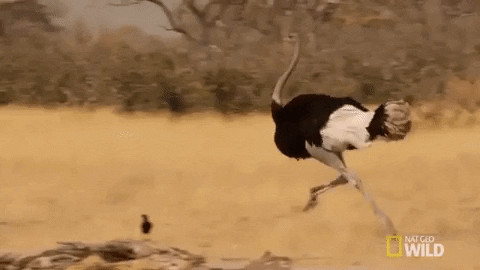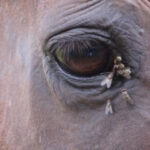Ostriches, the world’s largest birds, are renowned for their incredible speed and imposing size. They dominate the African savanna and beyond with their powerful legs and striking presence. Yet, despite being birds, they are famously flightless. This begs the question: why can’t an ostrich fly? Let’s delve into the fascinating reasons behind this evolutionary quirk and explore the adaptations that traded aerial prowess for terrestrial dominance.
Ostriches running at high speed then colliding with a fence, illustrating their ground-based nature and lack of aerial agility.
 Ostrich running into fence
Ostrich running into fence
Evolutionary Trade-offs: Flightlessness as an Advantage
The inability of ostriches to fly isn’t a deficiency, but rather an evolutionary adaptation that has proven remarkably successful in their specific environment. Over millions of years, ostriches evolved to thrive on the ground, where flight became less crucial for survival and other traits became paramount.
Adaptation to Terrestrial Life
Ostriches inhabit open grasslands and savannas where wide visibility and rapid movement on land are more advantageous than flight. Their environment doesn’t necessitate escaping to trees or soaring for food in the same way as for forest-dwelling birds. Instead, the open plains favor speed and stamina for evading predators and covering vast distances in search of food and water.
Predator Avoidance: Speed over Wings
While many birds rely on flight to escape danger, ostriches have developed an alternative strategy: incredible running speed. They are the fastest birds on land, capable of reaching speeds up to 45 miles per hour (70 km/h) in short bursts and maintaining a steady pace of 30 mph (50 km/h) over longer distances. This speed, combined with their keen eyesight and alertness, allows them to outrun most predators, including lions and cheetahs. For ostriches, powerful legs and speed became a more effective defense mechanism than the ability to take to the skies.
Energy Efficiency: Grounded for Good Reason
Flight is an energetically expensive activity, requiring significant muscle power and a high metabolic rate. For large birds like ostriches, maintaining flight would demand a tremendous amount of energy and food intake. By losing the ability to fly, ostriches reduced their energy expenditure, allowing them to survive on a diet of plants, roots, and seeds which are readily available in their habitat. This energy conservation is a key advantage in the often harsh and resource-scarce environments they inhabit.
Anatomical Constraints: Built for Land, Not Air
The physical characteristics of ostriches further explain their flightlessness. Their anatomy is distinctly adapted for running and ground-based survival, rather than aerial locomotion.
Wing Structure: Vestigial Wings
Ostriches do possess wings, but they are small and underdeveloped in proportion to their body size. Unlike flying birds with long, broad wings providing lift, ostrich wings are short and rounded. Their wing bones are solid and heavy, lacking the hollow, lightweight structure found in birds capable of flight. These wings are not capable of generating the lift required to overcome their considerable body weight. Instead, ostriches use their wings for balance while running, maneuvering at high speeds, and in mating displays.
Muscle Development: Legs over Chest
The muscle distribution in ostriches is drastically different from that of flying birds. Birds that fly have highly developed pectoral (chest) muscles, which power their wing movements. In contrast, ostriches have relatively small pectoral muscles and exceptionally powerful leg muscles. Their massive thighs and lower legs are packed with muscles designed for running and kicking. This muscular emphasis on the lower body further reinforces their terrestrial lifestyle and lack of flight capability.
Feather Structure: Insulation, Not Aerodynamics
Ostrich feathers also contribute to their flightlessness. Flying birds have feathers that are tightly interlocked, creating a smooth, aerodynamic surface essential for generating lift and reducing drag. Ostrich feathers, however, are soft, fluffy, and lack the interlocking structure of flight feathers. They are primarily adapted for insulation and display purposes, providing warmth in varying temperatures and playing a role in courtship rituals. These plumes are not designed to create the aerodynamic surfaces needed for flight.
Weight and Size: Too Big to Fly
Ostriches are the heaviest living birds, with adults weighing up to 320 pounds (145 kg) and standing as tall as 9 feet (2.7 meters). Their sheer size and weight are significant impediments to flight. Generating enough lift to get such a massive body airborne would require disproportionately large wings and incredibly powerful flight muscles – an evolutionary path that was not advantageous for them. Their size, while preventing flight, offers benefits in terms of predator deterrence and dominance in their environment.
Comparison of an ostrich brain to a walnut to emphasize the small brain size of ostriches, suggesting limitations in complex behaviors like flight.
 Ostrich brain vs walnut
Ostrich brain vs walnut
Advantages of Flightlessness: Thriving on the Ground
While flightlessness might seem like a disadvantage at first glance, it has actually equipped ostriches with unique strengths that allow them to flourish in their chosen habitat.
Speed and Agility on Land: Masters of the Savanna
As mentioned earlier, ostriches are unparalleled runners. Their long, powerful legs allow them to cover ground quickly and efficiently, making them highly mobile in their open environments. This speed is not only crucial for escaping predators but also for traveling long distances to find food and water sources, which can be scattered across vast territories.
Powerful Legs for Defense: Nature’s Weapon
Beyond running, ostrich legs are formidable weapons. Their strong legs and sharp claws deliver powerful kicks that can deter or even kill predators. A well-aimed kick from an ostrich can generate immense force, making them one of the few animals capable of killing a lion. This natural weaponry provides a significant advantage in their defense against threats.
Survival in Open Habitats: Perfectly Adapted
In summary, the flightlessness of ostriches is not a limitation, but a suite of adaptations that make them supremely well-suited to their open, terrestrial habitats. Evolution has sculpted them into ground-dwelling specialists, prioritizing speed, size, and strength over aerial abilities. Their inability to fly is a testament to the diverse paths evolution can take, leading to remarkable creatures perfectly attuned to their ecological niches. The ostrich stands as a powerful example of how losing one ability can pave the way for developing others that are even more advantageous in a specific context.

